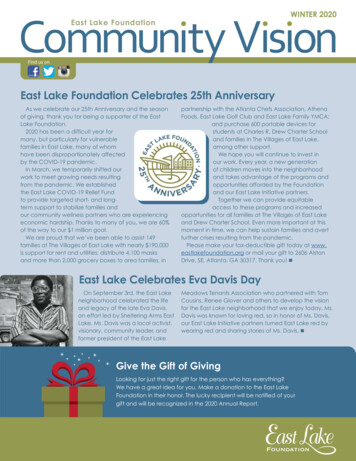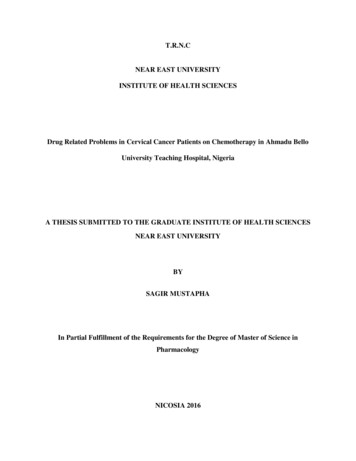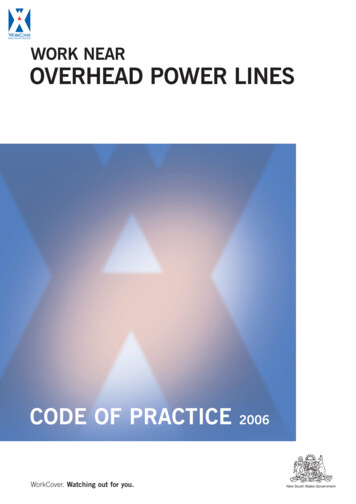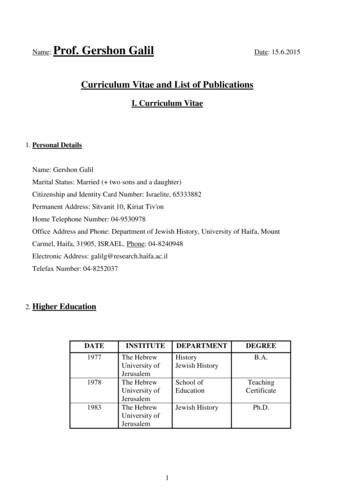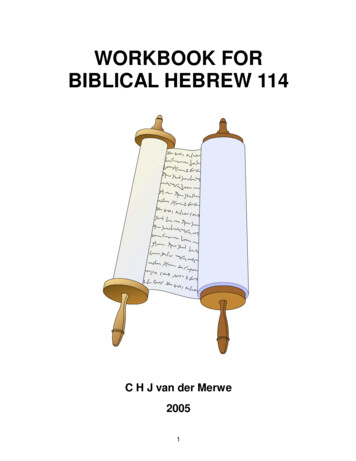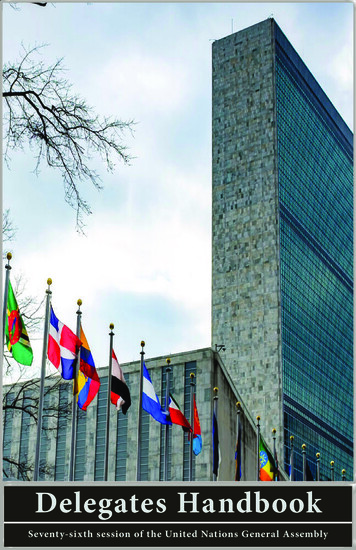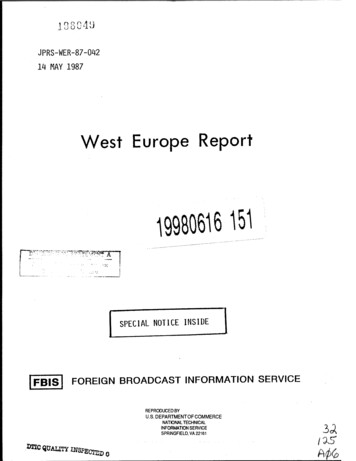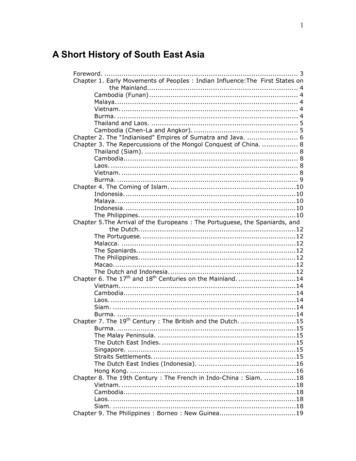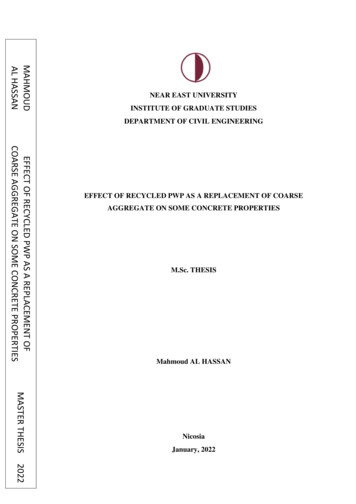
Transcription
MAHMOUDAL HASSANNEAR EAST UNIVERSITYINSTITUTE OF GRADUATE STUDIESDEPARTMENT OF CIVIL ENGINEERINGEFFECT OF RECYCLED PWP AS A REPLACEMENT OFCOARSE AGGREGATE ON SOME CONCRETE PROPERTIESEFFECT OF RECYCLED PWP AS A REPLACEMENT OF COARSEAGGREGATE ON SOME CONCRETE PROPERTIESM.Sc. THESISMahmoud AL HASSANMASTER THESISNicosiaJanuary, 20222022
NEAR EAST UNIVERSITYINSTITUTE OF GRADUATE STUDIESDEPARTMENT OF CIVIL ENGINEERINGEFFECT OF RECYCLED PWP AS A REPLACEMENT OF COARSEAGGREGATE ON SOME CONCRETE PROPERTIESM.Sc. THESISMahmoud AL HASSANSupervisorAssoc. Prof. Dr. Shaban Ismael AlbrkaNicosiaJanuary, 2022
1ApprovalWe certify that we have read the thesis submitted by Mahmoud AL HASAN titled “Effect ofRecycled PWP as a Replacement of Coarse Aggregate on Some Concrete Properties”and that in our combined opinion it is fully adequate, in scope and in quality, as a thesis forthe degree of Master of Educational Sciences.Examining CommitteeName-SurnameSignatureHead of the Committee:Assoc. Prof. Dr. Rifat Reşatoğlu. . Committee Member*:Asst. Prof. Dr. Mustafa Juma A. Mijarsh. . Supervisor:Assoc. Prof. Dr. Shaban Ismael Albrka. . Approved by the Head of the Department31 03 ./ ./2022 .Prof. Dr. Kabir SadeghiHead of DepartmentApproved by the Institute of Graduate Studies ./ ./2022Prof. Dr. Kemal Hüsnü Can BaşerHead of the Institute
2DeclarationI hereby declare that all information, documents, analysis and results in this thesis havebeen collected and presented according to the academic rules and ethical guidelines ofInstitute of Graduate Studies, Near East University. I also declare that as required bythese rules and conduct, I have fully cited and referenced information and data that arenot original to this study.Mahmoud AL HASSAN ./ ./202220 03
3AcknowledgmentsI would like to express my gratitude to my supervisor Assoc. Prof. Dr. ShabanISMAEL ALBRKA, and for his or her support and guidance for completing the projectwork successfully. Furthermore, I would like to thank Engineer Antonio Bouty and histeam who have facilitated my lab work in this thesisMahmoud AL HASSAN
4AbstractThe Effects of Partially Replacing Coarse Aggregates by Plastic WasteMaterials on Concrete PropertiesAL HASSAN MahmoudMA/PhD, Department of Civil EngineeringJanuary, 2022, seventy one (71) pagesA lot of severe environmental problems are caused every day by the disposalof wastes in a non-environmental way in landfills. For this reason, in order to reducethe environmental impacts and to use more resources in an efficient way, reusing thedemolishing waste became an urgent need. For this purpose, a 30 MPa concrete mixwas made with the following replacement percentages: 0%, 10%, 15%, and 20% ofplastic waste as a partial replacement of the Coarse aggregates. The fresh concreteproperties of the four mixes were determined by the slump test (mm) and the aircontent test (%). With regards to the tests on hardened concrete, the test of compressivestrength was carried out at seven, fourteen, and twenty-eight days on cylindrical ofdiameter equal to 150 mm and height equal to 300mm; in plus to the tests which wasdone at 28 days for water absorption and the tensile strength tests. In a conclusion, thereplacement of coarse aggregate partially by plastic waste materials showed anunclearly effect on the fresh on the concrete mixes properties. While 15% of plasticwaste particles gave, at 28 days, higher compressive strength and the moisture contentand the tensile strength decreasedKey Words: Plastic waste, environment, partial replacement of coarse aggregates,compressive strength, concrete properties.
5Table of ContentsApproval .1Declaration .2Acknowledgments .3Abstract 4Table of Contents 5List of Tables .8List of Figures .9List of Abbreviations .11CHAPTER IIntroduction to Solid Waste Management in Lebanon 12Solid Waste Sector in Lebanon .12Excavation in Lebanon .14Plastic Waste Generation in Lebanon 15Problem Statement .16Thesis Objective .17CHAPTER IILiterature Review and Experimental Plan . 18Introduction .18Polyethylene Terephthalate Particles' Effects on Concrete Properties . 19Fresh concrete properties . 19Concrete's mechanical properties .20Absorption of water .23Using Plastic Bottle Wastes in Concrete 23Using Glass in Concrete .25Definition of the Experimental Plan . 26Disadvantages of using plastic .27CHAPTER IIIMaterial Characterizations .28Overview 28
6Cement 28Plastic Waste Particles 29Fine Aggregates 29Grading .29Fineness Modulus .31Specific Gravity and Absorption .32Coarse Aggregates .34Grading .34Specific Gravity and Absorption .36Concrete Mix Design (30 MPa) 39The Conditions and Specifications 39Step 1 - Required Compressive Strength .39Step 2 - Water-to-Cement Ratio .41Step 3 - Air Content. 41Step 4 – Slump. 41Step 5 - Water Content .41Step 6 - Cement Content .42Step 7 - Coarse-Aggregate Content. 43Step 8 - Admixture Content .43Step 9 - Fine-Aggregate Content .43Step 10 - Moisture correction .44Preparation of Concrete Mixes . 45CHAPTER IVCharacterization of Concrete with Partial Replacement of Ca by Pwp .47Overview .47Fresh Concrete Tests .47Slump Test .47Air Content Test 51Hardened Concrete Tests 54Compressive Strength Test 54Splitting Tensile Strength Test .60Water Absorption Test . 63
7Oven-Dry Mass. 63Saturated Mass After Immersion. .63CHAPTER VGeneral Conclusions and Recommendations .66In closing 66Future Recommendations . 67REFERENCES 68APPENDICES . 70Appendix A. Ethics Approval Letter .70Appendix B. Similarity Index .71
8List of TablesTable 1. Chemical Analysis of Cement . 28Table 2. Physical Properties of Cement 29Table 3. Fine-Aggregate Grading Limits (ASTM C 33/AASHTO M 6) . 30Table 4. Available Fine-Aggregate Grading Results 30Table 5. Determination of Fineness Modulus of Fine Aggregates .32Table 6. Physical Properties of Fine Aggregates .34Table 7. Coarse-Aggregate Grading Limits (ASTM C 33)) .35Table 8. Available Coarse-Aggregate Grading . 35Table 9. Physical Properties of Coarse Aggregates .38Table 10. Maximum Required Water-Cementitious Material Ratios andMinimum Design Strengths for Different Exposure Condition 40Table 11. Requirements for Concrete Exposed to Sulfates in Soil or Water 40Table 12. Required Average compressive strength used without known data.40Table 13. Water-to-Cementitious-Material-Ratio Relationship 41Table 14. Approximate Requirements for Mixing Water and Target AirContent for Different Slumps and Nominal . 42Table 15. Minimal Requirements of Cementing Materials for ConcreteUtilized . 42Table 16. Bulk Volume of Coarse Aggregate per Unit Volume of Concrete.43Table 17. Mix Proportions of the Controlled Mix (30MPa) . 44Table 18. Mix proportions of 10%, 15%, 20% and 25% Replacement of 45Table 19. Slump Values for Different Percentages of Replacement (30 MPa)50Table20. Air Content for Different Percentages of Replacement (30 MPa) . 53Table 21. Compressive Strength Test Results at 7 Days .55Table 22. Compressive Strength Test Results at 14 Days 56Table 23. Compressive Strength Test Results after 28 Days 57Table 24. Results of Tensile Strength Test at 28 Days (30 MPa) .62Table 25. Calculation of Water Absorption of the 30 MPa Concrete Mix .64
9List of FiguresFigure 1. MSW Generation in Lebanon between 1995 and 2011 . 12Figure 2. Naameh Landfill 13Figure 3. Saida Dumpsite . 13Figure 4. MSW Dumped on The Beach of Saida And Burned on The Roads.14Figure 5. Green Area Before and After Excavation .15Figure 6. Waste Composition in Lebanon (GMI: The Green MED Initiative)16Figure 7. Methodology of Work .17Figure 8. Grading Curves of the Used FA and the Limits Specified in ASTMC 33 . 31Figure 9. Fine Aggregates of Diameter Less Than 4.75 mm 32Figure 10. Pycnometer Filled with Water and the FA at the SSD state 33Figure 11. Fine Aggregates (Dry Sample) 34Figure 12. Grading Curves of the CA Used and the Limits Specified inASTM C 33 36Figure 13. Coarse Aggregates (SSD Sample) .37Figure 14. Weight of the SSD sample in water 38Figure 15. Concrete ingredients with water in the mixer . 46Figure 16. Cylinders Filled With Concrete at Fresh State 46Figure 17. Cylinders cured in the water tank 46Figure 18. Slump Cone Filled to its Third Layer . 48Figure 19. Slump Cone while Removed .49Figure 20. Slump Measurement 49Figure 21. Slump Test Results .51Figure 22. Air Content test 52Figure 23. Air Content Test Results .53Figure 24. Sketches of Types of Fracture .54Figure 25. Columnar Fracture (Result of the compressive strength) . 55Figure 26. Evolution of Compressive Strength at 7 Days 56Figure 27. Evolution of Compressive Strength at 14 Days .57Figure 28. Evolution of Compressive Strength at 28 Days .58
10Figure 29. Evolution of the Compressive Strength of 30 MPa Concrete Mixfor 7, 14 and 28 Days at Different percentages of CA by PWP . 59Figure 30. Evolution of the Compressive Strength for 0%, 10%, 15% and20% of PWP as Replacement of CA at 7, 14 and 28 Days 60Figure 31. Cylinder positioned for the Indirect tensile strength test . 61Figure 32. Evolution of the Tensile Strength at 28 Days .62Figure 33. Evolution of Water Absorption With different ReplacementRatios .65
11List of AbbreviationsCA:Coarse AggregateFA:Fine AggregateFM:Fineness ModulusGMI:Green MED InitiativePWP:Plastic Waste ParticlesMSW:Municipal Solid WasteOPC:Ordinary Portland CementSSD:Saturated Surface DrySCC:Self-Compacting ConcretePVC:Polyvinyl Chlorideσs:Compressive Strengthσc:Splitting Tensile Strengthσf:Flexural StrengthPA:Plastic aggregate
12CHAPTER IIntroduction to Solid Waste Management in LebanonThis chapter will discuss waste plastic in Lebanon in general, including anintroduction, a problem statement, and the study's objective.Solid Waste Sector in LebanonLebanon has 5.8 million people and a population density of 560 people/km2,considered as one of the highest densities in the world. The municipal solid waste(MSW) generation has increased significantly from 0.83 kg/capita/day in 1995 to 1.05kg/capita/day in 2011 and is still increasing; Figure 1 shows an increasing of 26% inthe overall Municipal Solid Waste generation rate in Lebanon between 1994 and 2011(MOE/GEF/UNDP, 2015).Figure 1MSW Generation in Lebanon between 1995 and 2011Lebanon is suffering every day from specific and deep-rooted problems that areaffecting the collection, treatment and disposal of municipal solid waste. Since 1997,the Lebanese waste sector faced an emergency municipal solid waste managementplan that ended in July 2015(MOE). The culmination in the current national crisis oftrash was mainly caused by the premature closure of the largest sanitary landfill inLebanon located in Al Naameh in July 2015 (Figure 2).
13Figure 2Naameh LandfillThese problems have led to significant social, economic and environmentaldifficulties. In Lebanon, the open dumping as shown in Figure 3 and Figure 4, andopen burning of municipal waste as shown in Figure 5 is a common and widelyaccepted practice. Naameh landfill, Zahle landfill, and Tripoli controlled dumpsite, arethe three main landfills in Lebanon that deal with only 55% of the total solid waste inLebanon generated since 1998. The rest is either recycled/composted by some factoriesand some environmental communities or disposed in an open dumpsite by the localauthorities represented by the municipalities or unions of municipalities.Figure 3Saida Dumpsite
14The lack of a strategy that deals with the problem in a sustainable manner thatincludes the provision of some basic information such the waste composition andwaste quantities in addition to the failure in implementing some relevant laws andregulations that define the needed activities to improve the waste management andwaste utilization, and the failure in coordinating the activities of stakeholders havebeen identified as further key shortcomings in the sector.Figure 4MSW Dumped on The Beach of Saida And Burned on The RoadsRegardless all the studies that described the problems affecting the waste sectorin Lebanon and addressing some of the specific aspects that could help in solving thisproblem, like feasibility studies and comprehensive strategies in order to improve thesituation step by step; There is a top urgent need for a sustainable solution, that couldplan for a way that deal with the problem in a sustainable way, as the current situationis causing environmental, economic and social impacts that are destroying day afterday the beautiful nature of large parts of Lebanon.Excavation in LebanonCoarse aggregate production is responsible for different kind of pollution inaddition to the high amount of energy needed for the manufacturing process, starting
15by the extraction from the site and ending by the factory production. In addition, it cantransform glorious green areas to barren deserts such in Figure 5.Figure 5Green Area Before and After ExcavationPlastic Waste Generation in LebanonNowadays, the way that most of the countries are using to get rid of their wasteis becoming a very serious problem. For this reason, regenerating and reusing somewastes as new resources is becoming an urgent need to reduce the environmentalpollution and all the negative impacts that the waste is causing every day.Simultaneously, millions of tons of plastic waste are being generated annuallyall over the world and only limited amount is used towards the production of newplastic products. According to GMI, Lebanon produces 2.04 million tons of municipalsolid waste per year and plastic represents 11.5 % of this amount (Figure 6). Once theplastic becomes a waste, it is disposed at landfills, which is unsustainable becauseplastic is an inorganic material that cannot be naturally decomposed; in conclusion,Lebanon disposes more than 234000 tons of plastic waste at landfills that will staythere forever.
16Figure 6Waste Composition in Lebanon (GMI: The Green MED Initiative)Concrete is becoming one of the most consumed material after the waterworldwide, due to the rapid growth of structures. The global concrete industryconsumes around 10 billion tons of aggregates, and produces over 1 billion tons ofconstruction and demolition waste annually.One possible solution is to use plastic waste as a partial replacement of coarseaggregates in new concrete mixtures that helps reducing the toxic gases resulting fromquarries and valorizes plastic waste particles instead of being dumped in landfills.Problem StatementStudy of the Feasibility of Partially Replacing Coarse Aggregate with WastePlastic to Improve Concrete Properties. Many investigations on the qualities of plasticwastes, such as irrigation and agriculture pipes/pumps, have been done. We utilizedscrap Polyethylene Terephthalate (PET) bottles as a substitute for coarse materials inthis project. Aggregates in concrete are quite costly and have a significant role in theself-weight of concrete components in any concreting project. So we, as engineers,face us problems from the high weight in concrete and by replacing partial coarseaggregates, by plastic, we will be able to reduce the weight of concrete.
17Thesis ObjectiveThe main reason of this study is to create a better environment that is free frompolluted spaces, and to valorize the waste plastic material, by transforming them intosmaller particles size that will be partially replacing the coarse aggregates in theconcrete mixes. In order to experimentally verify the effect of the partial replacementof coarse aggregates by plastic particles in concrete, a literature review was first carriedout in order to set the experimental plan. A characterization of the materials used inthe laboratory in order to adjust the concrete mix design followed. Concrete mixeswith different replacement ratios of CA by (PWP) were then made and specimens wereprepared. Testing on fresh and hardened concrete were made in order to compare theconcrete containing PWP to a reference concrete. The optimal replacement ratio of CAwith (PWP) was finally determined. Figure 7 show us the processes.Figure 7Methodology of Work
18CHAPTER IILiterature Review and Experimental PlanThe past key efforts on the characteristics of concrete have been brieflymentioned and explained in this chapter.IntroductionDifferent authors of the bibliography studied the effects of recycled PWP as apartial replacement of CA on the mechanical properties of concrete. Replacing thepolymer with cement binders may produce polymer concrete, but its production is veryexpensive due to the high cost of conventional resins. Thus, many researchers focusedon producing resin from waste PET bottles for use in polymer concrete to lower theprice of resin produced according to a natural one. (Rebeiz et al., 1991; Rebes, 1995;Rebes and Fowler, 1996; Abdul Azim, 1996; Tawfiq and Iskander, 2006).Nevertheless, the production of polymer concrete from PET bottles is still very high.Another way is to convert waste PET bottles into plastic fibers and use them tomake reinforced concrete fibers (Silva et al., 2005; Ochi et al., 2007). But the quantityof plastic fiber that can be added to concrete is still very low (0.3% up to 1.5%, then itdoes not seem an effective way to eliminate the huge amount of PET waste bottles.The last method that one looks most reasonable is to use PET waste bottles andplastic aggregates in concrete, so it is possible to produce lightweight concrete,eliminate plastic waste PET bottles, reduce the environmental problem, reduce the useof totals Natural, which in turn reduces the distortion of nature due to the spread oftotal crushers in the mountains.Plastic use has become largely everywhere around the world lately, this makeshuge amounts of existing plastic waste. Plastic waste is currently a real natural hazardto the evolving way of life.Plastic waste is not buried in landfill because of its extensive and moderate therate of deterioration. Reusing plastic waste to deliver the latest materials such asaggregate in cement may be among other answers to disposal, due to their financialand natural preferences.In concrete, various types of plastic waste are used as aggregates, fibres or fillersafter mechanical handling. They contain polyethylene terephthalate bottles (PET),
19polyvinyl chloride, PVC channels, high-density polyethylene (HDPE), olystyrene,polyurethanefoam,polycarbonate, reinforced plastic glass (Akcaoz S, Atais CD and Akcaoglu K. 2010).Joining plastic aggregates (PA), or plastic fibers (PF) can basically enhancemany concrete properties because PA has higher rigidity, greater abrasive behavior,lower thermal connectivity and higher thermal capacity than conventional totals.Plastic aggregates are mainly very light weight compared to normal aggregate(NA) and along these lines, its fuse brings down the densities of the subsequentconcrete (Saikia N & de Brito J., 2010).This feature can be used to create lightweight concrete. However, the integrationof PA into concrete has some negative effects, for example, low workability and poormechanical behavior (Saikia N & de Brito J., 2010).Polyethylene Terephthalate Particles' Effects on Concrete PropertiesFresh concrete propertiesSeveral factors impact the workability of PET concrete, including the watercement ratio (w/c), the percentage level of PET aggregate, and the size of the PETaggregate.Albano et al. (2009) claimed that increasing the fine aggregate replacementquantity with waste PET bottles reduces the workability of concrete; nevertheless, itwas revealed that the higher the w/c ratio, the greater effect this addition has on theworkability. Furthermore, he asserted that when PET particle sizes get larger, thedetrimental impact on workability will grow. Two distinct w/c ratios (0.5 and 0.6) wereemployed in this investigation, as well as two different recycled PET replacementlevels (10 and 20% by volume) and two different particle sizes (0.26, 1.14 cm)(Albano, 2009).Choi et al. (2005), on the other hand, reported that the slump test of freshconcrete increased from 10 to 22.3 cm with 75 percent substitution of bottledlightweight aggregate (WPLA), implying a 123 percent increase in workability overthe control. This might be due to WPLA's spherical and soft nature, as well as its lowabsorption rate (Choi, 2005).
20Frigione (2010) discovered that when fine aggregate is substituted with wastePET bottles aggregates (WPET) at a rate of 5% by weight, the workability of theconcrete is somewhat poorer than normal concrete. (Frigione, 2010)According to Azhdarpour et al (2016), the results of experimental researchshowed that adding plastic particles derived from PET bottles to concrete changed itsphysical qualities. As the PET concentration of the concrete grew, the UPV and densityof the concrete decreased (Azhdarpour, 2016).Concrete's mechanical propertiesChoi (2005) used WPET to partially substitute fine particles as lightweightaggregates in concrete with granulated blast furnace slag (GBFS). After 28 days, itwas revealed that when using a w/c ratio of 0.73, the c of a specimen containing 25%WPET by volume of the entire mix as sand is reduced by roughly 6% when comparedto conventional concrete and by around 9% when compared to concrete with a w/c of0.45. For w/c of 0.73, the reductions were 19 percent, and for w/c of 0.45, they were15 percent (Choi, 2005).It is accounted for in a subsequent publication (Choi et al., 2009) the use oflightweight aggregate produced from waste PET bottles (WPLA) covered with fineparticles. WPLA aggregates have a water absorption rate of roughly 0%, which canhelp to correct the deformities of regular lightweight gravels, which have a high waterabsorption rate. The flow of WPLA mortar increased significantly as the percentageof plastic aggregate in the mortar rose. Similarly, the mortar σc (compressive strength)tended to decrease as the replacement amount of WPLA increased. After 28 days, theσc (compressive strength) of WPLA concrete specimens was lowered by 5, 15, and30% compared to conventional lightweight concrete, when the waste PET bottleaggregates percentages in the mixture were 25, 50, and 75%, respectively (Choi,2009).Different researchers investigated the performance of two separate mortars, thefirst built entirely of WPET aggregates and the second made entirely of WPET andfine aggregates (Akcaozog lu et al., 2010). Furthermore, blast-furnace slag was usedas a concrete substitute (at half of substitution on weight premise proportion). TheWPET/binder ratio and the water/binder (w/b) ratio used in the mixes were 0.45 and0.50, respectively. The crushed WPET particles used in the mortar combinationsranged in size from 0 to 4 mm. According to the results of the experiment, mortar
21containing only WPET, mortar including WPET and regular sand, and mortar usingslag as a bond substitute may all be termed lightweight concrete based on the strengthqualities and unit weight. Finally, the mortar containing WPET aggregates shrankfaster than the mortar comprising both WPET aggregate and regular sand.Albano (2009) investigated the mechanical characteristics of concrete using twodifferent w/c ratios (0.5 and 0.6), two different degrees of recycled PET replacement(10 and 20% by volume of aggregate), and two different plastic sizes (0.26 and 1.14cm). The results showed that as the volume extent and molecular size of WPETincreased, WPET-filled concrete revealed a decrease in σs (Splitting Tensile Strength),σc (compressive strength), modulus of elasticity, and UPV, as well as an increase inwater absorption rate. In any event, the fact that the concrete samples were not entirelycompacted was accounted for. Similarly, they revealed the formation of pores, whichhad a significant impact on the quality parameters (Albano, 2009).Pezzi et al. (2006) used WPET as aggregate in concrete and evaluated thephysical and mechanical properties of the mixtures. The integration of WPET withsizes ranging from 15 to 25 mm in amounts up to 10% by volume of an aggregate ofentire mix did not result in significant changes in σs (compressive strength) at low w/cratios (Pezzi, 2006).When the replacement level reached 50%, the drop in σs (Splitting TensileStrength) was 32.8 percent. Marzouk et al. (2007) investigated the use of discardedPET bottle aggregates in concrete after they had been separated, washed, and crushed.The substitution level of WPET was determined by the amount of fine aggregate inthe whole mixture. The experiment revealed that plastic particles might be usedefficiently as fine aggregates in concrete. When the percentage level of WPETinclusion increased from 0 to 50 percent, the σs (Splitting Tensile Strength) of mortarsteadily decreased by roughly 16 percent in comparison to regular concrete (Marzouk,2007).Ismail and AL-Hashmi (2008) researched in concrete the likelihood of utilizingdifferent wastes of plastic, comprising around 20 % polystyrene and 80 %polyethylene, as sand replacement, with sizes up to 4.75 mm. The outcomes reveal thatwhen the plastic content in concrete increased, the compressive strength tended todecrease at different curing age. When the plastic waste was added by 10 %, theconcrete showed the most reduced σc (compressive strength) after 28 days of curing,the loss reached around 30 % compared with the control mix (Ismail, 2008).
22Frigione (2010) discovered that when fine aggregate is substituted with wastePET bottle aggregates (WPET) at 5% by weight, the loss of σs(Splitting TensileStrength) is rather modest in contrast to conventional concrete (-0.02 MPa). Thisdecrease, was larger at higher w/c ratios (Frigione, 2010).According to Jaivignesh and Sofi (2017), as the percentage of WPET added rosefrom 10% to 20%, σs (Splitting Tensile Strength) decreased from 10% to 24% whencompared to the reference concrete. Similarly, the σf (flexural strength) decreaseranged between 20 and 30 percent (Jaivignesh, 2017).Sadrmomtazi et al. (2016) reported that in self-compacting concrete when thereplacement level of waste PET aggregates was 5% and the proportion of cementsubstituted with silica fume was 10%, the σf(flexural strength) of the mixture fell byup to 14.7% compared to the reference at 28 days. Furthermore, when WPETconcentration is 10% and 30% fly ash is used to substitute cement, this decreasereaches 34.6 percent. As a result, including WPET into the concrete has a significantimpact on lowering the f of self-compacting concrete (SCC). Similarly, leftover PETparticles in SCC mixtures reduce concrete specimens' splitting tensile strength.Expanding the PET component from 5% to 15% reduces the σs (compressive strength)of concrete samples by about 48.8%. They also said that when the PET concentrationgrows, the ultrasonic pulse velocity (UPV) rates decrease because WPET raises theporosity rate of the mixes (Sadrmomtazi, 2016).Azhdarpour et al. (2016) found that when the replacement ratios of fineaggregate by waste PET aggregates in concrete were 5 and 10%, the σs(compressivestrength), σc(splitting tensile strength), and σf(flexural strength) of the specimens rose.But, when the replacement level above 10%, all the mechanical parameters of theconcrete samples declined. As a result, utilizing polyethylene terephthalate asaggregates improves the mechanical characteristics of concrete if the fine aggregatesubstitution level with PET particles does not exceed 10% (Azhdarpour, 2016).
23Absorption of waterAccording to Akcaozoglu et al. (2010), mortars containing both WPET andregular sand (Mix3 and Mix4) had lower water absorption than mortars having onlyWPET (Mix1 and Mix2). Regardless, the porosity ratios of M1 and M2 mixes werelower than those of M3 and M4 mixes (Akçaözoğlu, 2010).Sadrmomtazi et al. (2016) found that adding WPET enhanced the waterabsorption rates of all mixes. This is due to the flat surface of PET aggregates and therestriction of cement hydration rate in WPSCC mixtures.According to Saiki and Brito (2013), adding WPET to concrete samples up to a10% substitution level improves permeability (Sadrmomtazi, 2016).Using Plastic Bottle Wastes in Concrete.T. Ochi a, (2007) employed it in this study to make concrete PET fiber fromdiscarded PET bottles with a 3 percent content. Extrusion apparatus fo
MSW Generation in Lebanon between 1995 and 2011 Lebanon is suffering every day from specific and deep-rooted problems that are affecting the collection, treatment and disposal of municipal solid waste. Since 1997, the Lebanese waste sector faced an emergency municipal solid waste management plan that ended in July 2015(MOE).

